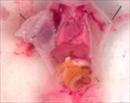Dnah5b2b2395Clo
Chemically induced Allele Detail
|
|
| Symbol: |
Dnah5b2b2395Clo |
| Name: |
dynein, axonemal, heavy chain 5; Bench to Bassinet Program (B2B/CVDC), mutation 2395 Cecilia Lo |
| MGI ID: |
MGI:5552945 |
| Synonyms: |
Peaches |
| Gene: |
Dnah5 Location: Chr15:28203898-28472198 bp, + strand Genetic Position: Chr15, 10.9 cM
|
| Alliance: |
Dnah5b2b2395Clo page
|
|
Mutant 2395-006-LB presents with heterotaxy and dextrocardia with levogastria
Show the 18 phenotype image(s) involving this allele.
|

|
|
| Strain of Origin: |
C57BL/6
|
| Project Collection: |
B2B/CvDC
|
|
| Allele Type: |
|
Chemically induced (ENU) |
| Mutation: |
|
Single point mutation
|
| |
|
Mutation details: This ENU-induced mutation was isolated in a screen at the University of Pittsburgh. The molecular lesion is a T to A substitution at nucleotide +2 after coding nucleotide 7398 (c.7398+2T>A, NM_133365) in intron 44. This changes splice donor site G-GT to G-GA (which is assumed to be inactive).
(J:175213)
Additional
incidental mutations
were detected in sequencing for the causative mutation,
Dnah5b2b2395Clo, and may be present in stocks carrying this mutation.
|
|
|
View phenotypes and curated references for all genotypes (concatenated display).
|
|
|
|
|
|
|
|
Summative Diagnosis:
Heterotaxy including Situs inversus totalis
Cardiovascular Phenotype: Dextrocardia and and complex congenital heart defects associated with heterotaxy, including anomalous systemic venous return, atrioventricular septal defect (AVSD), right atrial isomerism (RAI), biventricular hypertrophy, and hypoplastic pulmonary artery. Also observed are mutants with situs inversus totatlis without congenital heart defects
Noncardiovascular Phenotype: Abnormal thoracic and abdominal organ situs anomalies, such as left lung isomerism, dextrogastria/levogastria, and dual inferior vena cava (IVC). A few mutants exhibited malaligned sternal vertebra, immotile airway cilia and craniofacial anomalies including micrognathia, cleft palate, duplex kidneys, and short snout
|
 Analysis Tools
Analysis Tools




